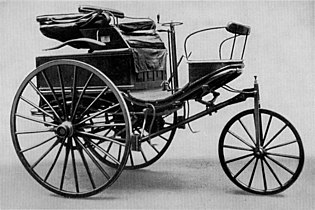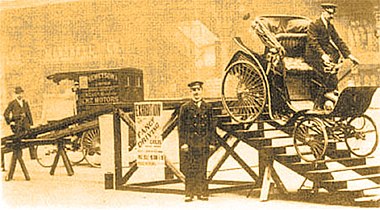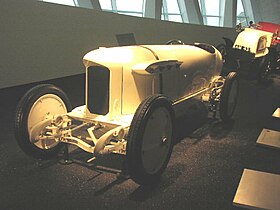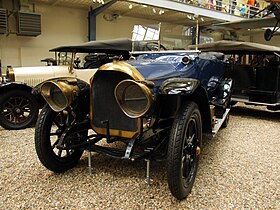Benz & Cie.
| Benz & Cie., Rheinische Automobil- und Motorenfabrik AG
|
|
|---|---|
| legal form | Corporation |
| founding | October 1, 1883 (as Benz & Cie. Rheinische Gasmotorenfabrik ) |
| resolution | July 1, 1926 |
| Reason for dissolution | Merger with Daimler-Motoren-Gesellschaft to form Daimler-Benz AG |
| Seat | Mannheim |
| management |
|
| Number of employees |
|
| Branch | Mechanical engineering , automobile manufacturer |
The Benz & Cie. was a German mechanical engineering and automotive company that was founded by Carl Benz in Mannheim in 1883 and later expanded with operations in Mannheim-Waldhof and Gaggenau . After the spin-off of Motoren-Werke Mannheim AG (MWM) in 1922 (to this day one of the largest manufacturers of stationary engines ), Daimler-Benz AG (today Daimler AG ) was created through merger with Daimler-Motoren-Gesellschaft in 1926 .
history
Benz & Cie. Rheinische gas engine factory in Mannheim
The engineer Carl Benz , the first working his 1879 two-stroke - gas engine had developed was excreted from which he founded in Mannheim Gasmotorenfabrik 1,883th On October 1st of the same year he founded Benz & Cie. Together with the businesspeople Max Caspar Rose and Friedrich Wilhelm Eßlinger . Rheinische gas engine factory in Mannheim . The new company was able to sell over 800 stationary engines in the first four months .
In 1886 the company received the patent for the new three-wheel ligroing gas - velocipede , which was offered as Benz Patent Motorwagen number 1 . Benz & Cie. the first automobile manufacturer in Germany. More three- and four-wheeled automobiles were built in quick succession. While Benz & Cie. Manufactured the chassis and engines, the Mannheim-based Stellmacherbetrieb Kalkreuther supplied almost all the superstructures and bodies. 80 of the two-stroke engines could be sold in 1886 and by 1891 there were already 500 engines, most of which were exported.
In 1890 the two partners Rose and Eßlinger left the company. Friedrich von Fischer and Julius Ganß, who, like Benz, saw the future in the construction of automobiles, became new co-owners. In 1891, Benz reinvented the steering knuckle for his vehicles.
From 1887 to 1899 the number of employees rose from 40 to 430. By 1893 only 69 vehicles were produced, but by the turn of the century there were already a total of 1709 vehicles. The number of motor vehicles in detail: 69 to 1893, then 67, 135, 181, 256, 434, 572 and 603 in 1900.
Corporation

On June 8, 1899, Benz & Cie. (or Benz & Co., as some sources indicate) in Benz & Cie. Rheinische Gasmotoren-Fabrik AG renamed; Benz and Ganß were the directors of the new stock corporation . The founders of the AG were Benz, Ganß, Fischer, Rose and Jean Ganß. The supervisory board included Rose, Carl Reiss , Simon Hartogensis , Richard Brosien, Isidor Haas, Jean Ganß, Heinrich Perron and Hermann Andreae.
In the new century, when the owners of the company had just bought land to build a new factory in the Mannheim suburb of Waldhof, sales suddenly plummeted: The main competitor, Daimler-Motoren-Gesellschaft in Stuttgart , had the Formerly the largest automobile factory in the world, it took decisive market shares. Ganß then engaged the French designer Marius Barbarou , who also brought with him plans for a completely new series that replaced the outdated Benz designs and came out under the name of Parsifal. The "oldest and largest special factory in the world for motor vehicles" - according to its own advertising - advertised the following models in 1902: 4½, 6, 10, 12, 15 and 20 hp. 3,600 of the motor vehicles have already been delivered.
Barbarou was presented to the public as the designer of the new Benz cars, which annoyed Benz so much that he retired from active work in the company in 1903. The new series did not significantly improve the company's situation either, and so Ganß and Barbarou left the company in 1904, and Benz became chairman of the supervisory board.
The new shareholders Georg Diehl and Fritz Erle had the model range thoroughly revised by the new designer Hans Nibel and finally ensured the necessary economic success again in 1905, mainly with vehicles of the upper and luxury class. But the racing cars were also made by Benz & Cie. world famous. The best- known model was the Blitzen-Benz from 1909.
Works in Gaggenau and Waldhof
Benz & Cie. saw further market opportunities in the construction of trucks, although there was not enough space in the Mannheim plant. Therefore, from 1907 onwards, they cooperated with the Süddeutsche Automobilfabrik GmbH in Gaggenau and took over the company and its production facility entirely in 1909. The Süddeutsche Automobilfabrik had mainly occupied itself with the construction of trucks, its little extensive car production was given up.
The space in the old Mannheim plant was soon no longer sufficient for car production either. In 1908 and 1909, a completely new factory for automobile production was built on the property in Waldhof that Benz and Ganß had bought years ago.
The stationary engines - still a mainstay of the company - continued to be manufactured in Mannheim city center. For 1910, the number of employees at Benz & Cie. indicated with 2500 in the Mannheim plant and 840 in the Gaggenau plant.
Benz & Cie., Rheinische Automobil- und Motorenfabrik
Since the manufacture of automobiles had become the main line of business, the company changed again in August 1911 : the new company was now called Benz & Cie., Rheinische Automobil- und Motorenfabrik AG .
From 1911 Benz & Cie. also again smaller automobiles with approx. 2 liters displacement, which were then also the basis of the war and post-war production. The collaboration with Edmund Rumpler did not bring the hoped-for success, although a Benz teardrop car emerged as a racing car. Before and during the First World War, aero engines were also built in Mannheim (see Benz Bz III ).
In 1922 the manufacture of stationary engines was outsourced and sold to the Berlin financial group Fonfé. This continued to operate the factory in Mannheim city center as Motoren-Werke Mannheim AG (MWM) (today as a brand of Caterpillar Energy Solutions one of the largest manufacturers of gas engines and gensets, especially for combined heat and power plants ).
Merger with Daimler
Starting in 1921, the Berlin stock market speculator Jakob Schapiro had gained more and more influence in the company through daring financial transactions and compensation deals (Benz Motorwagen versus its Schebera bodies). After all, he was represented on the supervisory board, and by 1924 he owned 60% of the shares in Benz & Cie. AG. In the same way he had also gained influence in other German automobile companies, including a. at Daimler-Motoren-Gesellschaft (DMG) in Stuttgart, at NAG in Berlin, at Hansa-Lloyd in Bremen and at NSU in Neckarsulm. With his speculative business, Schapiro brought all these companies to the brink of bankruptcy, whereby DMG was most likely to hold out due to its economic strength.
The CEO of Benz & Cie., Wilhelm Kissel , therefore started merger negotiations in 1924 with the former competitor DMG, with whom they had already had a sales cooperation for some time. In 1925, Kissel was also appointed as a board member of DMG. On July 1, 1926, the two companies flowed into the new Daimler-Benz AG with headquarters in Stuttgart-Untertürkheim in a ratio of 654 (Daimler): 346 (Benz) .
Vehicle models
Benz Patent Motor Car No. 1 , 1886
Benz Patent Motor Car No. 3 : In 1888 Bertha Benz drove it from Mannheim to Pforzheim
Patent motor car "Velo" 1894 first production car: 1045 cm³, 1.5 HP, 20 km / h ( EFA Museum )
Presentation of the Benz Velo in London, 1898
First petrol bus from Benz & Cie. Built in 1895 for the Netphener bus company
Blitzen-Benz , 1909
Benz 16/40 hp , 1913
Benz 16/40 HP , 1914
Benz 21/50 hp , 1914 custom-made by the body construction company Josef Neuss in Berlin-Halensee for Karl Max von Lichnowsky .
| Timeline of the Benz models from 1885 to 1926 | |||||||||||||||||||||||||||||||||||||||||||||
|---|---|---|---|---|---|---|---|---|---|---|---|---|---|---|---|---|---|---|---|---|---|---|---|---|---|---|---|---|---|---|---|---|---|---|---|---|---|---|---|---|---|---|---|---|---|
| class | 1880s | 1890s | 1900s | 10s | 20s | ||||||||||||||||||||||||||||||||||||||||
| 5 | 6th | 7th | 8th | 9 | 0 | 1 | 2 | 3 | 4th | 5 | 6th | 7th | 8th | 9 | 0 | 1 | 2 | 3 | 4th | 5 | 6th | 7th | 8th | 9 | 0 | 1 | 2 | 3 | 4th | 5 | 6th | 7th | 8th | 9 | 0 | 1 | 2 | 3 | 4th | 5 | 6th | 7th | 8th | 9 | |
| Microcar | number 1 | No. 3 | |||||||||||||||||||||||||||||||||||||||||||
| Small car | Bike | ||||||||||||||||||||||||||||||||||||||||||||
| ideal | |||||||||||||||||||||||||||||||||||||||||||||
| Elegant | Parsifal | ||||||||||||||||||||||||||||||||||||||||||||
| Lower middle class | Spider, Tonneau | 6/14 hp | 6/18 hp | 6/45 hp | |||||||||||||||||||||||||||||||||||||||||
| Dos-à-Dos |
Tonneau, Phaeton |
18 hp | 10/18 hp | 8/18 hp | 8/20 hp | ||||||||||||||||||||||||||||||||||||||||
| Middle class | Victoria | 10/20 hp | 10/25 hp, 10/30 hp | 10/30 hp, 10/35 hp | W 02 ... | ||||||||||||||||||||||||||||||||||||||||
| 12/30 hp | |||||||||||||||||||||||||||||||||||||||||||||
| 28/30 hp | 14/30 hp | ||||||||||||||||||||||||||||||||||||||||||||
| 20/35 hp |
16/35 hp, 16/40 hp |
||||||||||||||||||||||||||||||||||||||||||||
| 35/40 hp | 24/40 hp | 11/40 hp | |||||||||||||||||||||||||||||||||||||||||||
| 25/45 hp | 18/45 hp | ||||||||||||||||||||||||||||||||||||||||||||
| upper middle class | 21/50 hp | 16/50 hp | |||||||||||||||||||||||||||||||||||||||||||
| Upper class | 50 hp, 28/50 hp | 25/55 hp | 25/65 hp | 25/55 hp | |||||||||||||||||||||||||||||||||||||||||
| 60 hp, 35/60 hp | 29/60 hp | ||||||||||||||||||||||||||||||||||||||||||||
| 70 hp, 37/70 hp | 33/75 hp | 27/70 hp | |||||||||||||||||||||||||||||||||||||||||||
| 39/100 hp | |||||||||||||||||||||||||||||||||||||||||||||
| Sports car | 82/200 hp | ||||||||||||||||||||||||||||||||||||||||||||
| race car | Prince Heinrich carriage | RH wagon | |||||||||||||||||||||||||||||||||||||||||||
| Blitzen-Benz / 200 hp | |||||||||||||||||||||||||||||||||||||||||||||
See also
- Mercedes-Benz Veterans Club of Germany
- History of the automobile
- History of the commercial vehicle industry
literature
- Hans-Otto Neubauer, Michael Wessel: The automobiles of the Benz city Gaggenau. Neubauer-Verlag, Hamburg 1986, ISBN 3-926139-00-5 .
- Werner Oswald : Mercedes-Benz Passenger Cars 1886–1986. Motorbuch-Verlag, Stuttgart 1987, ISBN 3-613-01133-6 .
- Mercedes-Benz AG (Ed.): Benz & Cie. For the 150th birthday of Karl Benz. Motorbuch-Verlag, Stuttgart 1994, ISBN 3-613-01643-5 .
- Hans-Erhard Lessing a. a. (Ed.): The Benzwagen. Wellhöfer-Verlag, Mannheim 2008, ISBN 978-3-939540-19-9 . (Reprint of the corporate publication from 1913)
Web links
- Documents and newspaper articles on Benz & Cie. in the press kit 20th Century of the ZBW - Leibniz Information Center for Economics .
- Benz & Cie.
Individual evidence
- ↑ Olaf von Fersen (ed.): A century of automobile technology - commercial vehicles. VDI-Verlag, Düsseldorf 1987, ISBN 3-18-400656-6 , p. 14 f.
- ^ Hans Christoph von Seherr-Thoss : The German automobile industry. Documentation from 1886 until today . Deutsche Verlags-Anstalt, Stuttgart 1974, ISBN 3-421-02284-4 , p. 17 .
- ↑ German Reich Gazette 1899/133














